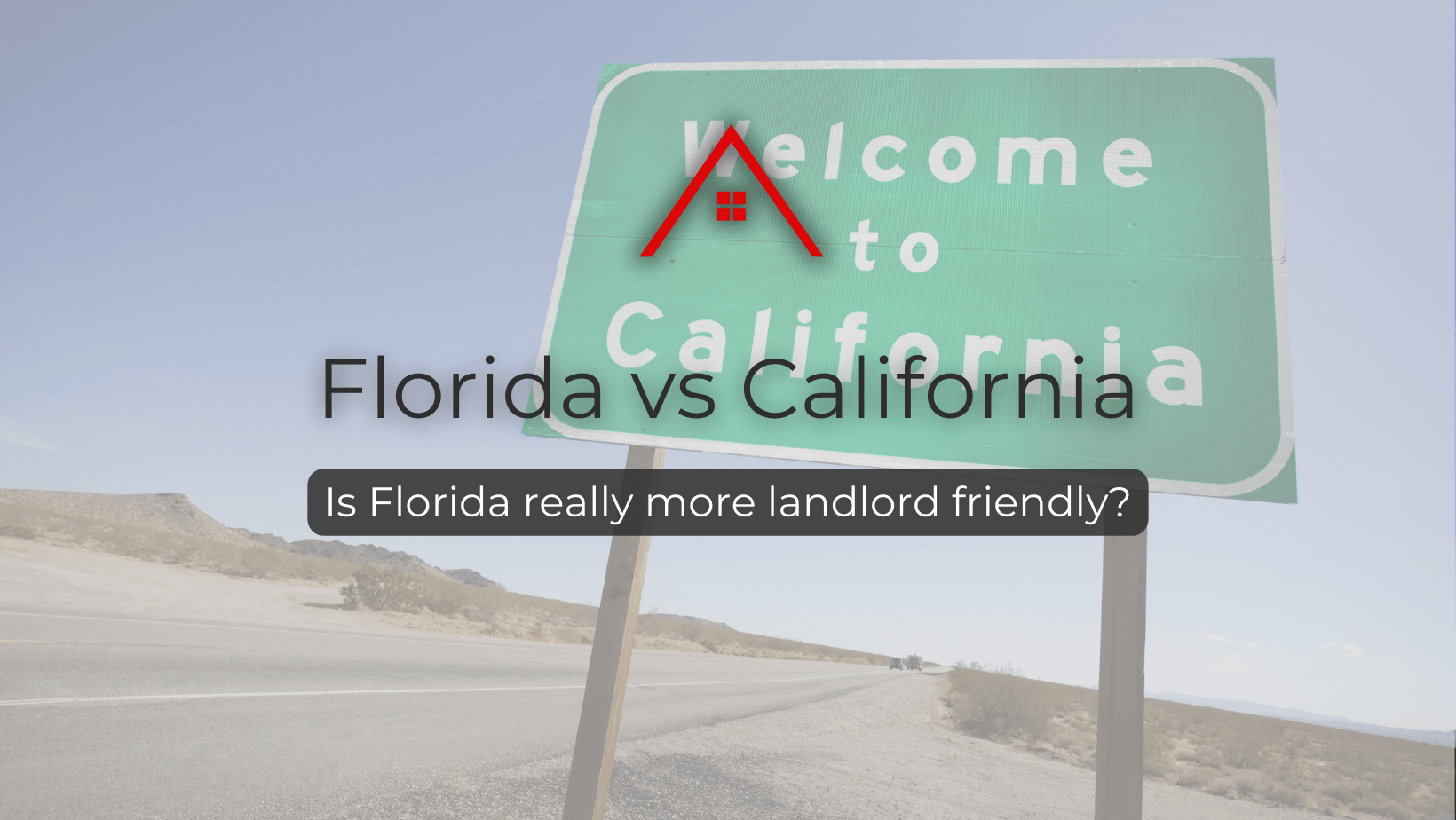Hey future investors! Whether you’re new or old, beginner or seasoned, welcome. Here’s an interesting comparison that I’d like to explore.
You constantly hear how Florida is a landlord friendly state and California is not. But have you really compared them? Well, I did and here’s what I found..
If you are looking to buy your next rental property in Tampa Bay and value my insight, you can schedule a time to talk with me one on one below.
Security Deposit Rules
There are a few items here to discuss. We’re talking about how the deposit works, how much is allowed, and returning the deposit.
Right off the bat we have California imposing restrictions on the free market! Effective July 1st, 2024, they have a deposit cap of ONE months worth of rent for both furnished and unfurnished rentals. Prior to that new legislation, the cap was 2 months of rent for unfurnished, and 3 months for furnished units.
Florida does not have a restriction. This is good because a property manager might be able to qualify a renter with poor credit if they pay higher deposits. This makes the risk worth it to the landlord, and the renter is able to live in their ideal rental if they choose to pay the deposit. Remember, a deposit is 100% returnable if the renter leaves the unit in similar condition minus reasonable wear and tear.
Florida’s new law allows landlords to accept monthly fees instead of a traditional security deposit. On paper it looks similar to an insurance policy. The tenant pays a very small monthly amount that is nonrefundable, but this allows them to bypass some of the high upfront moving expenses. To my knowledge, this has not been legislated in California.
Landlords are given strict deadlines to return deposits in both states. In Florida, landlords must return the deposit within 15 days if they are not claiming anything. If they are claiming part or all of the deposit, they must write to the tenant with 30 days of move out. The tenant has the right to object, but after the initial notice is sent to the tenant, the landlord has 30 days from then to deliver the remaining portion of the deposit, if any.
In California, landlords must return the deposit or provide an itemized statement of deductions within 21 days of the tenant moving out. Deductions can be made for unpaid rent, damage excluding ordinary wear and tear, cleaning, and restoration costs.
Rent Control and Increases
No surprise here that Florida does not have any rent control laws. Spoiler.. California does.
Rent control is the act of local government mandating the maximum allowable increase in rent each year when a tenant renews.
California has rent control laws, and local governments can create their own rent control laws. The statewide maximum rent increase percentage is typically 5% plus the rate of inflation or 10%, whichever is lower. If a tenant was to move out, the landlord is then free to advertise rent at the new fair market value. Interesting enough, landlords are able to increase rent twice within a 12 month period in California (though not to exceed the cap) with 30 days notice. If a tenancy is month-to-month, 90 days notice is required by landlord to tenant to increase the rent more than 10%.
Landlords in Florida cannot change the rent during the middle of a lease unless otherwise agreed to prior to signing. The rent schedule and lease can be modified however the landlord and tenant agree. Upon renewal of the unit, the rent can raised to fair market value or a smaller increase if the landlord prefers to keep a good tenant.
Eviction Processes
The eviction processes in Florida and California are also very different, shaped by each state’s unique legal frameworks and tenant protections. Florida wins here with a more streamlined process.
In Florida, the eviction process is more straightforward and faster compared to California. Florida law mandates landlords to serve tenants with a notice, the length varies based on the reason for eviction – for instance, non-payment of rent requires a three-day notice. If the tenant fails to comply with the notice, the landlord can then file an eviction lawsuit. Once the court issues a judgment in favor of the landlord, a writ of possession is issued, and the sheriff’s office enforces the eviction. This process can be relatively swift, often taking a few weeks and sometimes a couple of months.
Conversely, California’s eviction process is generally more tenant-friendly and can be prolonged and complex. The process begins with the landlord providing a notice (such as a three-day notice for non-payment of rent). However, if the tenant does not comply, the landlord must file an eviction lawsuit and serve the tenant with a summons and complaint. California tenants have the opportunity to respond to the lawsuit, potentially leading to a court hearing. If the landlord wins, a writ of possession is issued, but even then, tenants may request a stay of execution, delaying the eviction. Additionally, California’s laws adds requirements for the return of security deposits and detailed documentation of any property damage claims, adding more steps to the process.
Property Entry Rules
This is an aspect that becomes very annoying very quick when you need to access the property for maintenance or perhaps during a sale for showings or inspections. Everyone has the right to privacy, but occasionally the need arises within a 12 month lease to access.
Florida statutes generally require landlords to provide “reasonable” notice before entering a rental property. This is typically interpreted as at least 12 hours’ notice, though 24 hours is the practical standard across the industry due to convenience and courtesy to the tenant. Florida allows landlords to enter for reasons such as repair, maintenance, or showing the property to prospective buyers or tenants. In case the tenant objects, the landlord may use keys to enter the property as long as the reason for entering is written in the lease (showing, repairs, annual inspection, etc)Ab.
California has very similar requirements. California landlords are required to provide a 24-hour written notice before entering a rental property for the same reasons as those above. In case of emergency (fire, flood, blood, etc), exceptions are made in both states.
Maintenance and Repairs
In Florida, landlords are required to maintain their rental properties in a condition that meets basic structural, health, and safety standards. This includes functional plumbing, intact roofing, safe stairs and railings, and compliance with health, building, and safety codes. The state’s guidelines are somewhat broad, offering flexibility in how landlords fulfill these duties. Timely responses to repair requests are expected, but Florida law does not specify exact timeframes, leaving “reasonable” time to respond open to interpretation. Florida law does not allow a tenant to deduct repair expenses from rent if the landlord does not authorize. However, the tenant is able to withhold rent under specific circumstances – mainly related to the habitability of the property. There are stringent procedures in place to do this and tenants cannot withhold willy nilly!
California law is very similar to Florida. California typically requires landlords to address repair issues within 30 days, with urgent problems needing faster responses. The state also permits tenants to perform necessary repairs and deduct the costs from their rent if the landlord fails to make critical repairs promptly.
Neither state unnecessarily restrict landlords from operating their rentals, but require landlords to maintain functionality and habitability.
I think it’s safe to say Florida wins! While there are a few categories where they’re tied, California is generally much more friendly to tenants than landlords.
I’ve had hundreds of conversations with Californian investors looking to invest into Florida. And Tampa specifically. If that’s you, connect with me on my calendar at the top! Look forward to talking with you about all the opportunities we have here whether it’s long term, vacation rental, or coliving (Padsplit).





